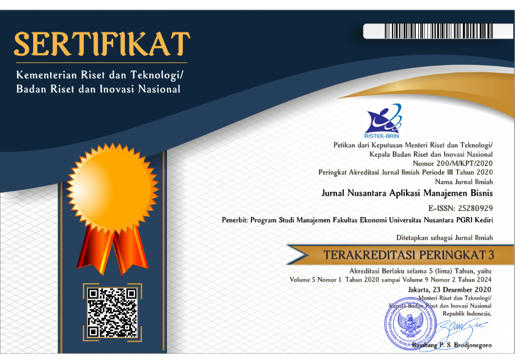Financial Distress Prediction Using Springate and Altman Model: Based on Financial Indicators of Industrial Companies
DOI:
https://doi.org/10.29407/nusamba.v10i1.22285Keywords:
Financial Distress, Springate, Altman Model, Financial IndicatorsAbstract
Research Aim: To develop the Altman and Springate models to estimate the likelihood of financial distress in the industrial sector for the 2015-2021.
Method: Analysis of data from 52 industrial companies listed on the Indonesia Stock Exchange (2015-2021) using Altman discriminant analysis and Springate S-Score to identify financial distress.
Research Finding: Out of 52 companies, 27 experienced financial distress. The Altman model demonstrated better prediction accuracy.
Theoretical Contribution: This paper strengthens the validity of the Altman and Springate models in predicting financial distress in the industrial sector.
Practical Implication: Provides insights for investors and management to anticipate bankruptcy risks and improve financial stability.
Research Limitation: Limited to the industrial sector in Indonesia for the 2015-2021 period and relies solely on financial statement data without considering external factors.
Downloads
References
[2] Sumbodo J. Perbandingan model diskriminan dan model logit untuk memprediksi financial distress perusahaan manufaktur di bei.
[3] Lestari EP, WSU I. ANALISIS KINERJA INDUSTRI MANUFAKTUR DI INDONESIA. J Ris Ekon dan Manaj. 2017 May 12;17(1):183. doi: 10.17970/jrem.17.170115.ID.
[4] Kulkarni KG, Wague C, Warrier PN. Avoiding the Middle Income Trap: Evidence and Examination of Few Countries. Saudi J Econ Fin. 2022;6(1):29-36. doi: 10.36348/sjef.2022.v06i01.00X.
[5] RAHAYU P. ANALISIS PENGGUNAAN METODE SPRINGATE (S-SCORE) SEBAGAI PREDIKTOR KEBANGKRUTAN.
[6] Altman EI. Financial ratios, discriminant analysis and the prediction of corporate bankruptcy. The journal of finance. 1968 Sep 1;23(4):589-609. doi:10.2307/2978933.
[7] Miller, R. D., & Springate, D. J. (1978, August). The Relationship of Strategy, Structure and Management Processes. In Academy of Management Proceedings (Vol. 1978, No. 1, pp. 121-125). Briarcliff Manor, NY 10510: Academy of Management.
[8] Zhang Y, Wu C, Zhang XY. Enterprise financial distress prediction based on BPNN: a case study of Chinese listed companies. Information Technology Journal. 2013 Dec 1;12(23):7684.
[9] Arasu R, Balaji CD, Kumar SP, Thamizhselvi N. Applicability of Fulmer and Springate models for predicting financial distress of firms in the finance sector–An Empirical analysis. Journal of Finance and Risk Management. 2013;4(1):1-9.
[10] Hungan AG, Sawitri NN. Analysis of financial distress with springate and method of grover in coal in BEI 2012-2016. International Business and Accounting Research Journal. 2018 Jul 6;2(2):52-60. doi:10.15294/ibarj.v2i2.39.
[11] Martini R, Aksara RR, Sari KR, Zulkifli Z, Hartati S. Comparison of Financial Distress Predictions With Altman, Springate, Zmijewski, and Grover Models. Golden Ratio of Finance Management. 2023 Mar 31;3(1):11-21. doi:/10.52970/grfm.v3i1.216.
[12] Shalih RA, Kusumawati F. Prediction of financial distress in manufacturing company: a comparative analysis of Springate model and Fulmer model. Journal of Auditing, Finance, and Forensic Accounting. 2019 Oct 20;7(2):63-72. doi: 10.21107/jaffa.v7i2.6717.
[13] Tahu GP. Predicting financial distress of construction companies in Indonesia: a comparison of Altman Z-score and Springate methods. International Journal of Sustainability, education, and Global Creative Economic (IJSEGCE). 2019 Jul 31;2(2):7-12. doi:10.21107/jaffa.v7i2.6717.
Downloads
Published
Issue
Section
License
Copyright (c) 2025 Diky Paramitha

This work is licensed under a Creative Commons Attribution-ShareAlike 4.0 International License.
Authors who publish with this journal agree to the following terms:
- Copyright on any article is retained by the author(s).
- The author grants the journal, the right of first publication with the work simultaneously licensed under a Creative Commons Attribution License that allows others to share the work with an acknowledgment of the work’s authorship and initial publication in this journal.
- Authors are able to enter into separate, additional contractual arrangements for the non-exclusive distribution of the journal’s published version of the work (e.g., post it to an institutional repository or publish it in a book), with an acknowledgment of its initial publication in this journal.
- Authors are permitted and encouraged to post their work online (e.g., in institutional repositories or on their website) prior to and during the submission process, as it can lead to productive exchanges, as well as earlier and greater citation of published work.
- The article and any associated published material is distributed under the Creative Commons Attribution-ShareAlike 4.0 International License












